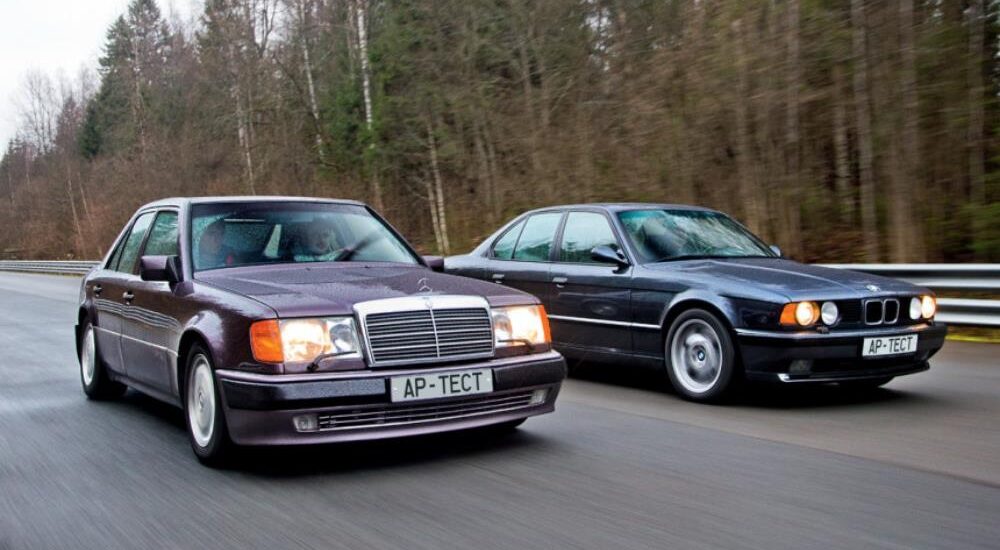Wölfe im Schafspelz? Mitnichten. Selbst in ihren Basismodellen geben der BMW E34 und der Mercedes-Benz der Baureihe 124“ nicht vor, etwas anderes zu sein als das, was sie sind: Raubtiere. In ihren eleganten italienischen Anzügen verströmen sie das Flair eines Wall Street Wolfs. Doch als M5 und 500 E verwandeln sie sich in wahre Monster, sobald sie den Firmenparkplatz verlassen.
Während die letzten Nieselregen des Novembertauwetters auf die Windschutzscheibe prasseln, muss ich den Herbst nur noch sechs Sekunden lang festhalten. Vor mir liegt die Gerade des Dmitrovsky-Testgeländes, und die Hinterreifen meines BMW greifen in die letzten trockenen Asphaltstücke. „Endlich treffen wir uns, M5“, denke ich, “und ich brauche jetzt deine ganze dunkle Magie.“
Oft habe ich gehört, dass der spätere E39 M5 „nicht mehr derselbe ist“, dass der echte, ungezähmte Geist des M5 in den frühen 90er Jahren bei der E34-Version geblieben ist, die nie einen Kragen trug. Doch meine eigene Erfahrung mit einem makellosen E34, selbst einer Standardversion, blieb mir bisher verwehrt. Stattdessen gelang es einem Kollegen vor drei Jahren, einen BMW 535i gegen einen Mercedes-Benz 300 E antreten zu lassen. Seitdem bin ich wie besessen davon, den ultimativen Showdown zu arrangieren, denn der M5 von damals hat nie an den Tests von Auto Review teilgenommen, und auch seinem Erzrivalen, dem Mercedes-Benz 500 E, sind wir nie begegnet.
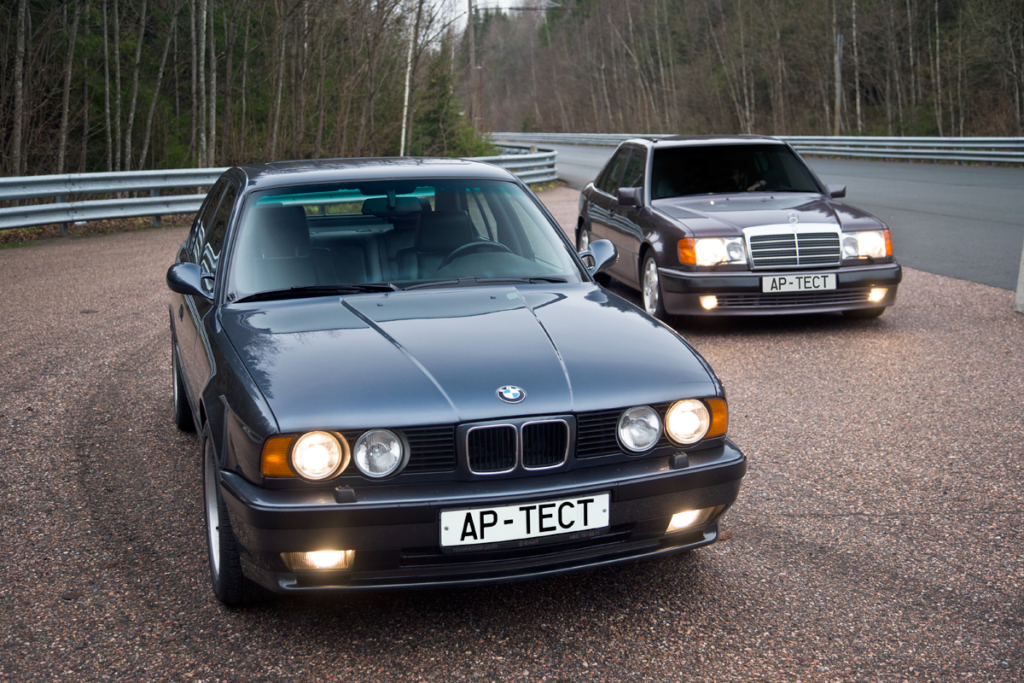
Jetzt nähern sich beide Autos langsam der Schranke des Testgeländes, ihre Halogenscheinwerfer aus dem goldenen Zeitalter des Automobilbaus erhellen den Parkplatz. Dieser Artikel mag unter der Kategorie „Retro-Test“ erscheinen, aber lassen Sie sich nicht täuschen. Die Digitalanzeige des BMW zeigt gerade einmal 26.900 km an, während der Kilometerzähler des Mercedes 88.550 anzeigt. Können solche Biester wirklich altern?
In Wirklichkeit ist nur der Kilometerstand des BMW überprüfbar; der Mercedes hat wahrscheinlich mindestens die dreifache Strecke zurückgelegt. Der 500 E kam 1990 auf den Markt, aber unser Exemplar wurde im April 1992 hergestellt und fand seinen ersten Besitzer in Hamburg. Fünf Jahre später kam er nach Russland und wurde in diesem Sommer vollständig restauriert und in seinen ursprünglichen Zustand versetzt.
Der BMW, ein Jahr jünger als der 500 E, gehört zur E34 M5-Serie, die 1988 begann. Kurz nach dem Erscheinen des Fünf-Liter-Mercedes wurde er jedoch erheblich aufgewertet, und 1992 kamen weitere Verbesserungen hinzu. Unsere Limousine, die im September 1993 montiert wurde, zeigt eine verbesserte Version des M5 mit einem stärkeren S38B38-Motor und dem Nürburgring-Paket, das adaptive, elektronisch gesteuerte Dämpfer, breitere Hinterräder und Servotronic-Lenkunterstützung umfasst.
Diese dreißig Jahre alten Klassiker im Showroom-Zustand sind der Traum eines jeden Liebhabers. Doch der Preis für ihre ewige Jugend ist hoch. Heute erzielen sowohl der BMW M5 als auch der Mercedes 500 E in vergleichbarem Zustand ähnliche Preise wie in den frühen 90er Jahren: zwischen 60.000 und 80.000 Dollar. Aber da das Alter heute nur noch eine Zahl ist, heben wir uns den Vergleich mit den Zeugnissen für später auf. Den ewig Jungen winkt die Straße. Sie sollen sich beweisen. Aber zuerst müssen sie gewogen werden.
Das Wiegen vor dem Test bestätigt nicht nur die Spezifikationen, sondern prüft auch das eigene Urteilsvermögen. Der ‘124’ sieht kompakt und raffiniert aus, der E34 schlank und straff, als gäbe es nichts Überflüssiges an ihrem Design oder ihrer Bauweise. Der Begriff „leicht“ kommt einem in den Sinn, aber das ist nicht ganz richtig. Beide Limousinen bringen siebzehnhundert Kilogramm auf die Waage. Der Mercedes wiegt mit vollem 90-Liter-Tank (ohne Fahrer) 1763 kg, wobei 53 % des Gewichts auf die Vorderachse entfallen. Der BMW ist um etwa dreißig Kilogramm leichter, obwohl er zwei Zylinder weniger, ein Schaltgetriebe statt einer Automatik und einen 80-Liter-Tank hat. Dennoch ist seine Achslastverteilung nahezu perfekt.
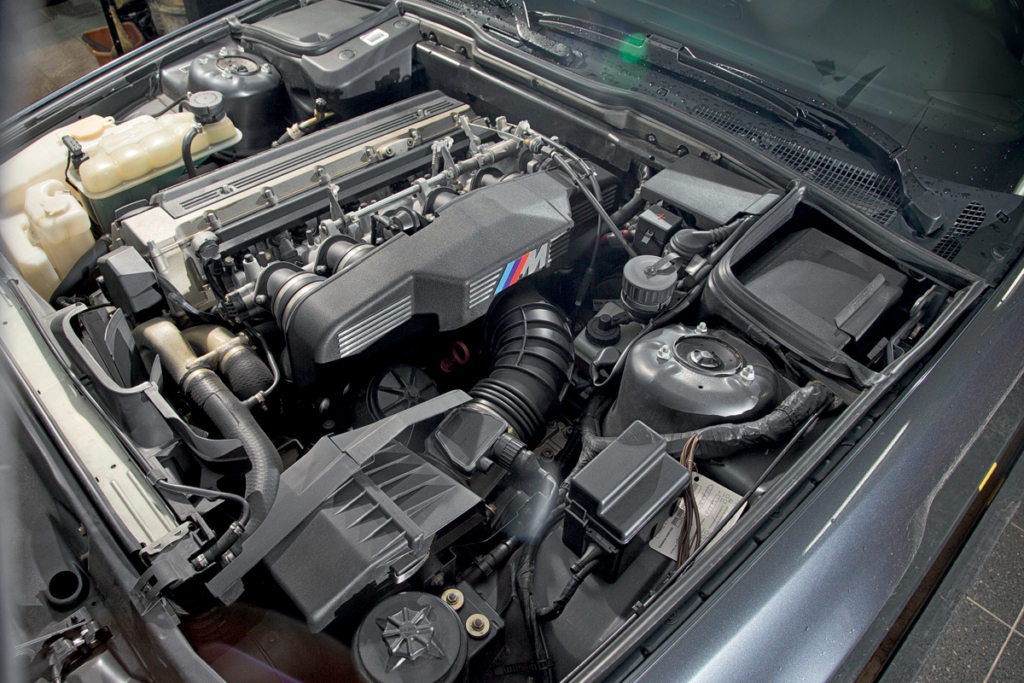
Der 3,8-Liter-Reihensechszylinder-Motor des BMW leistet 340 PS und hat damit einen deutlichen Leistungsgewicht-Vorteil: 5,1 kg pro PS (oder 196,6 PS pro Tonne). Der Fünf-Liter-V8 des Mercedes leistet 326 PS, wobei jedes PS 5,4 kg bewegt (oder 184,9 PS pro Tonne). Die Drehmomentwerte sprechen jedoch eine andere Sprache: 400 Nm aus München gegenüber 480 Nm aus Stuttgart. Und es ist wichtig, diese Leistung zu nutzen, solange die Straßen noch trockenem Asphalt ähneln.
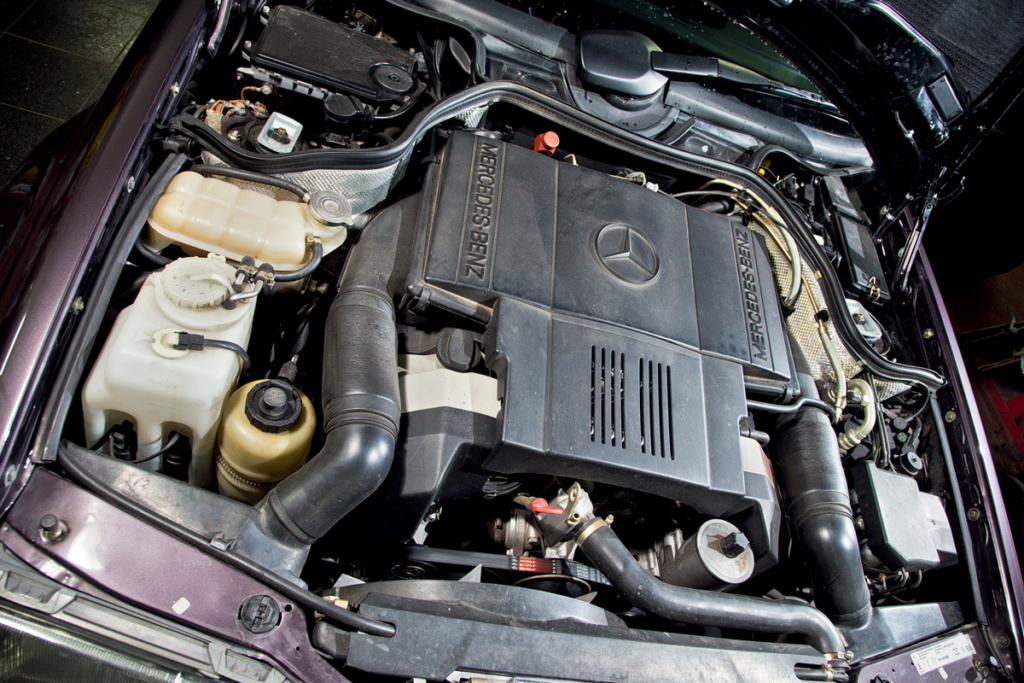
An diesem Morgen habe ich mich zunächst für den Mercedes entschieden. Seine Ausstrahlung ist reicher, seine großen, weit geöffneten Scheinwerfer strahlen Positivität aus. Die nach oben geneigten orangefarbenen Blinker suggerieren Fröhlichkeit, aber die breiten Schultern der vorderen Kotflügel deuten auf eine trügerische Robustheit hin. Die Ästhetik des ‘124’ ist bezaubernd. Seine Karosserieteile sind wie ein Stoff, der die Kraft darunter verbirgt, der sich am Dach und an den Säulen eng anschmiegt, aber darunter freier fließt. Nur die Radkästen ragen unter dieser „Hülle“ hervor und lassen die Kraft erahnen, die darin steckt.
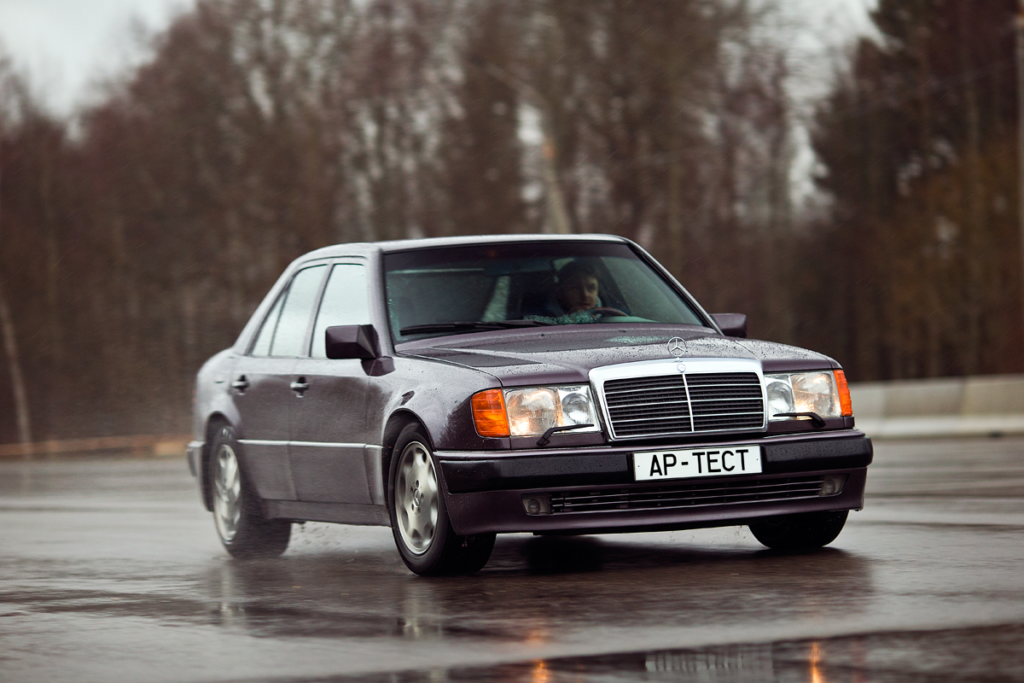
Überraschenderweise steht der „Fünfhunderter“ auf nur 16-Zoll-Rädern. Die Werksbereifung im Format 225/55 R16 war bei allen 500 Es Standard, mit Ausnahme der limitierten Evo-Version, die mit 17-Zoll-Rädern ausgestattet war.
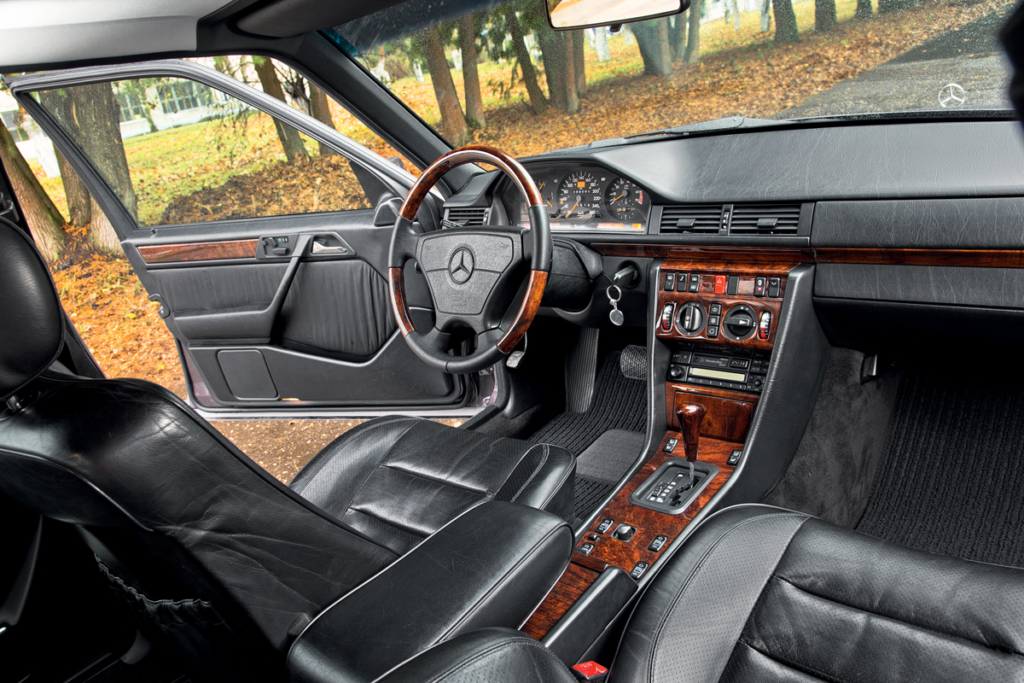
Es ist auch überraschend, in einem älteren Mercedes einen konturierten Sitz zu finden, der sowohl Seitenhalt als auch Oberschenkelpolster für Komfort bietet, obwohl das Leder ein wenig glatt ist. Das Lenkrad lässt sich nur in der Reichweite elektronisch verstellen. Die Anzeigen sind typisch für einen normalen W124 „Dreihunderter“, nur unterschieden durch die gelben Ganganzeigen auf dem Tacho und einen Drehzahlmesser, der 500 Umdrehungen pro Minute früher – nicht später – beginnt als der Basis-Mercedes.
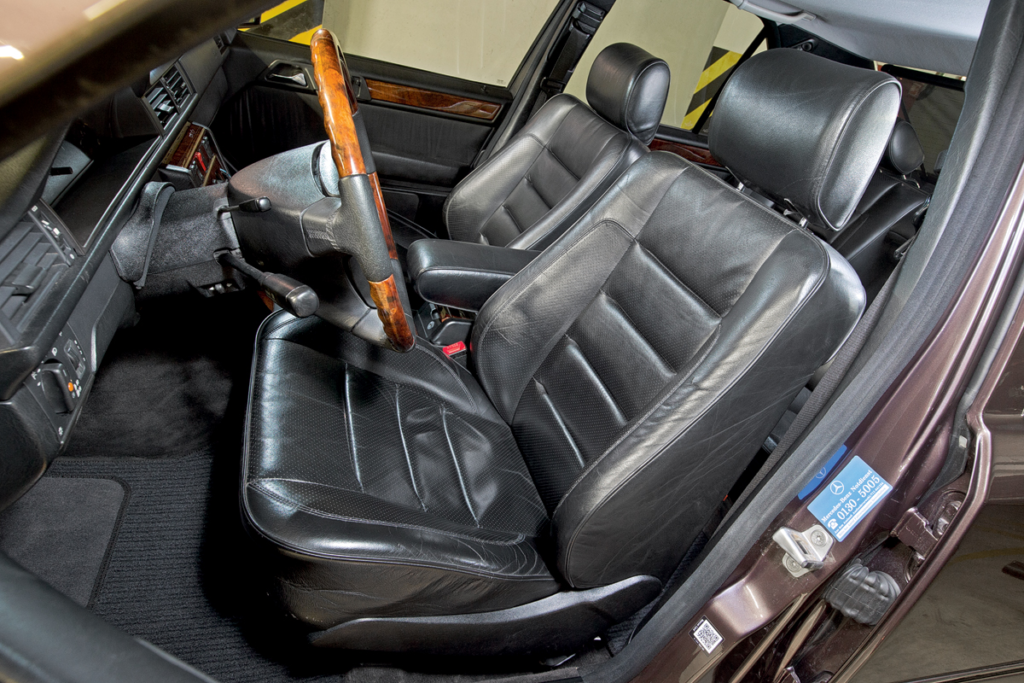
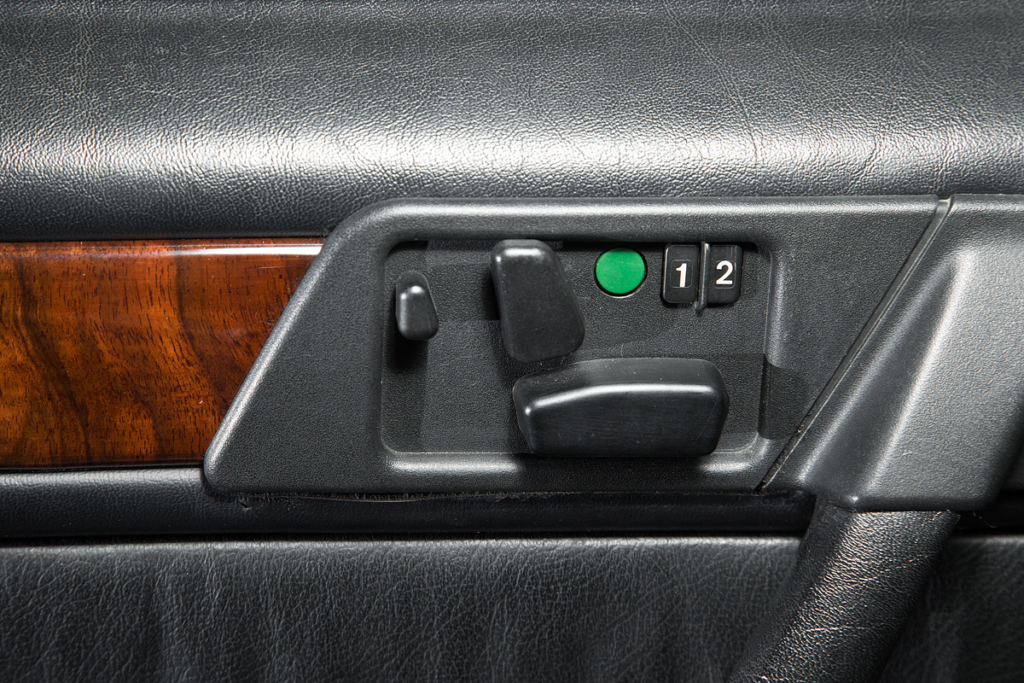
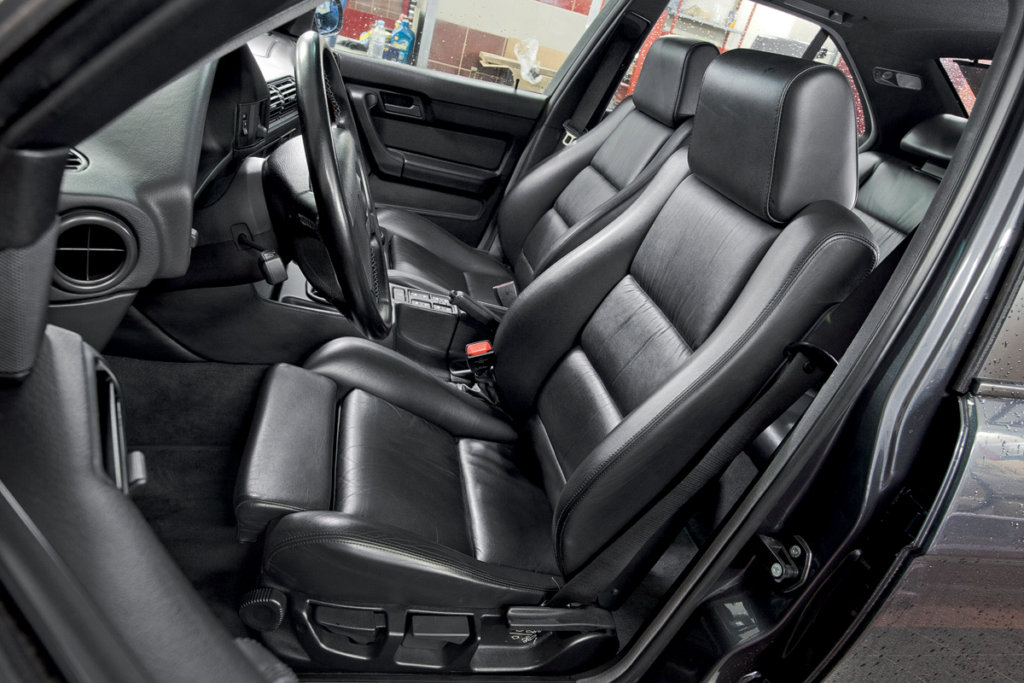
Der Motor erwacht lautstark. Der Hebel des Automatikgetriebes klickt leise in „D“, und der „Fünfhunderter“ zieht sanft auf das Gaspedal los. Die Lenkung ist ziemlich leicht und fühlt sich in der Mitte leer an, gewinnt aber in Kurven eine angenehme Rückstellkraft. Die Automatik versucht, mit dem Gaspedal Schritt zu halten. Die Federung ist weich, und ich merke, dass ich mich vielleicht in dem Wall-Street-Wolf getäuscht habe. Im Alltag bevorzugt dieser Mercedes eindeutig private Psychotherapiesitzungen.
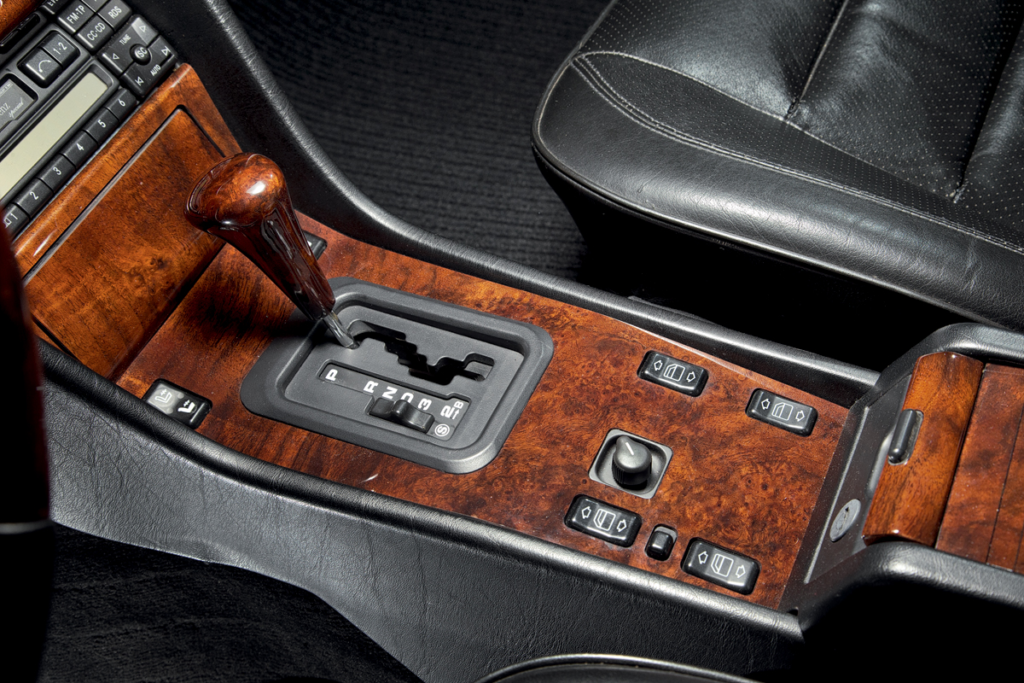
Sind Sie nervös, eine legendäre Superlimousine auf Sommerreifen durch Pfützen zu steuern, wenn die Temperaturen um den Gefrierpunkt liegen? Entspannen Sie sich und denken Sie daran: Ein Mercedes bleibt ein Mercedes, auch wenn er in Zusammenarbeit mit Porsche fein abgestimmt wurde. Merken Sie, wie ruhig das Fahrwerk auf Lenkeingaben reagiert? Wie geschmeidig die Federung auf dem Weg zum Prüfstand über das Kopfsteinpflaster des Testgeländes gleitet? Sehen Sie, es gibt keinen Grund zur Sorge, alles ist berechenbar und sicher.
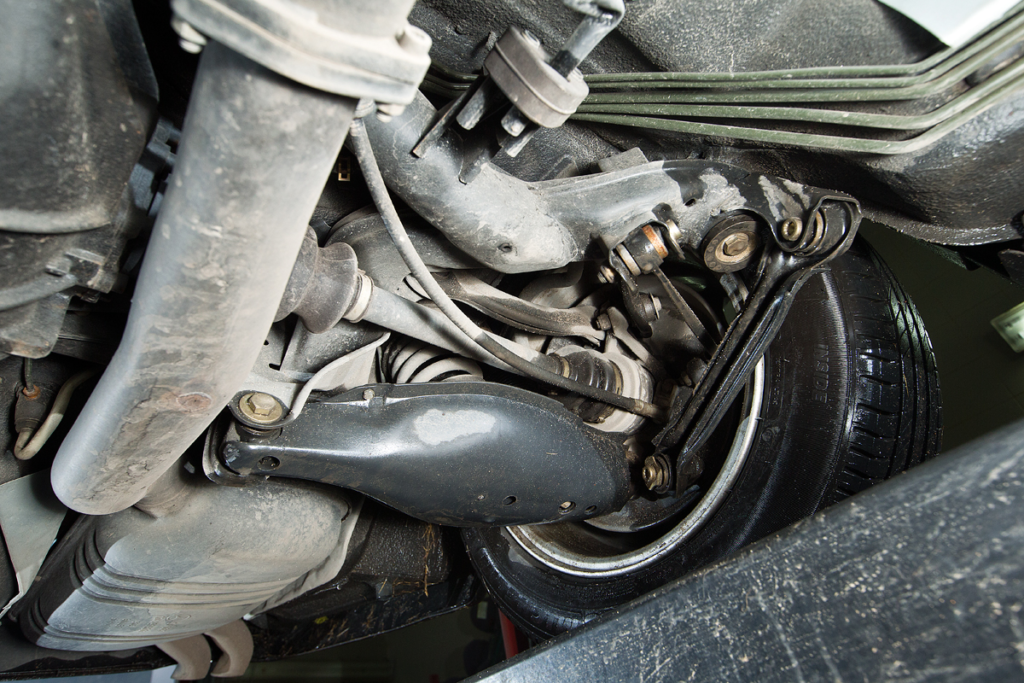
Fühlen Sie sich beruhigt? Ausgezeichnet. Treten Sie jetzt das Pedal durch und drücken Sie es auf den Boden. Beschleunigen Sie!
Wow, die Verwandlung des 500 E ist immer wieder unerwartet. Ich habe den halben Tag damit verbracht, ihn zu fahren, und war jedes Mal, wenn ich das Pedal durchtrat, aufs Neue erstaunt. Die Bandbreite der Temperamente in dieser Limousine ist unglaublich groß.
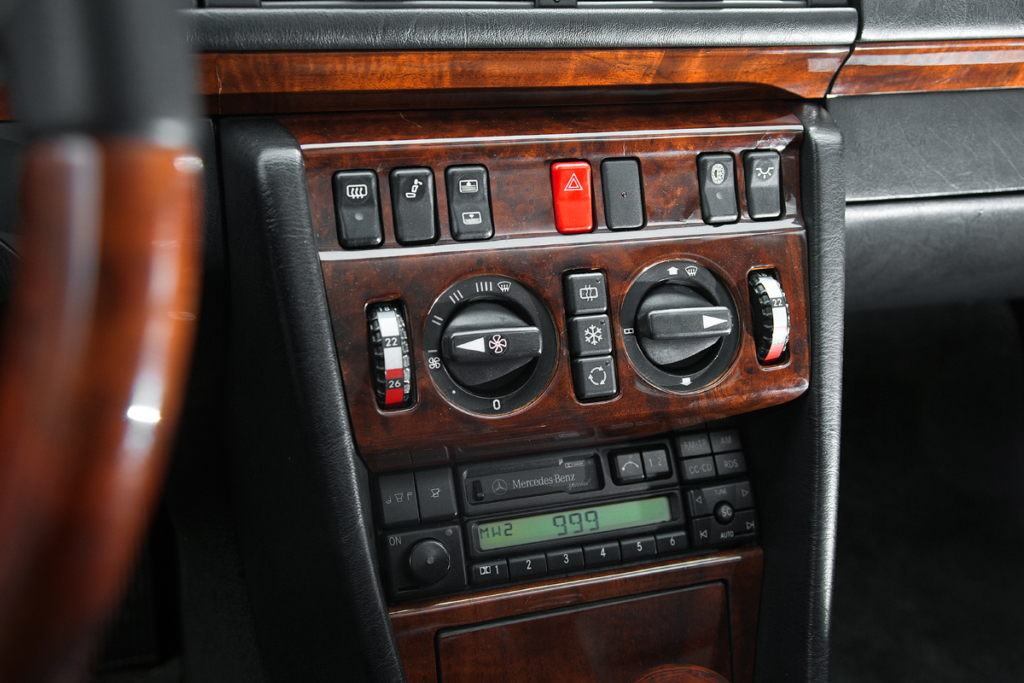
Der Mercedes schießt vorwärts, die Nase hebt sich nach einem kurzen Zögern beim Start leicht. Ein pulsierendes Infraschall-Dröhnen erfüllt den Innenraum und scheint durch das hölzerne Armaturenbrett zu hallen wie ein teurer Lautsprecher. Es ist, als hätte man das perfekte Soundsystem.
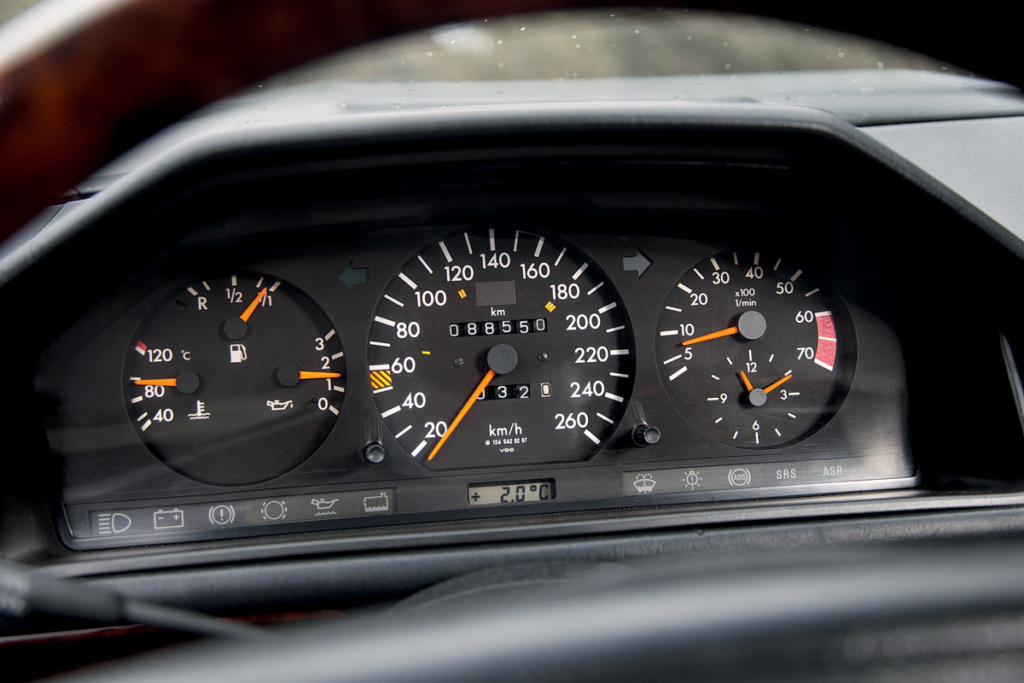
Auf der Suche nach der trockensten Stelle gelingt es mir, die Beschleunigung zu messen, ohne dass die nicht deaktivierbare Antriebsschlupfregelung ASR anspringt. Der anfängliche Schub erreichte bis zu 0,9 g. Der Motor drehte bis 6000 U/min und blieb dabei innerhalb der roten Linie. Die Schaltvorgänge erfolgten zügig und präzise. Der 500 E beschleunigt im ersten Gang auf fast 80 km/h und im zweiten auf bis zu 120 km/h. Das ist aufregend und lebendig, obwohl die Zahlen zeigen, dass er nicht ganz so schnell war, wie er sich anfühlte. Aus dem Stand auf 60 km/h dauerte es 3,5 Sekunden, und auf 100 km/h waren es glatte sieben Sekunden. Von 100 auf 200 km/h dauerte der beste Lauf 21,5 Sekunden. Aber wenn man ihn weiter schiebt, wird es ein bisschen beängstigend.
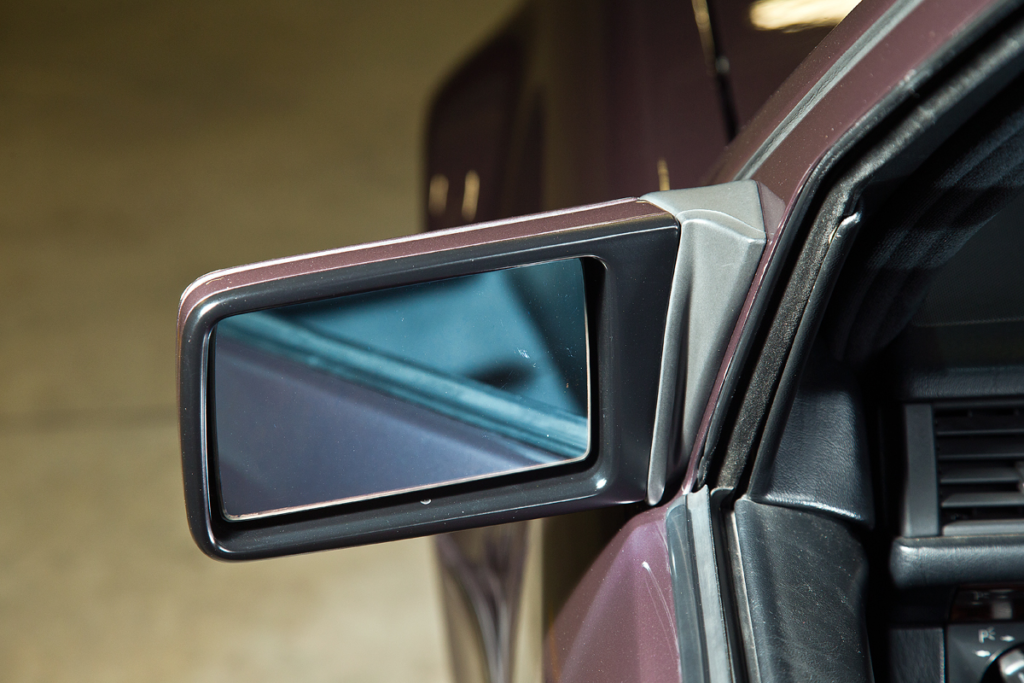
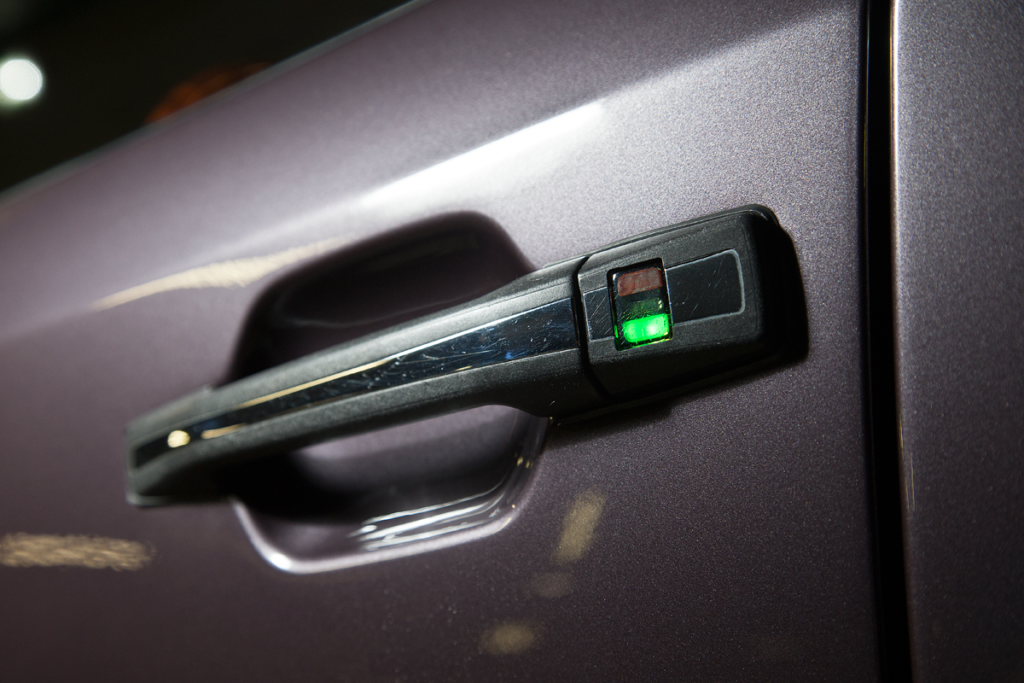
Bei mehr als 150 km/h verliert der Mercedes irgendwie die Stabilität und fängt an, von einer Seite zur anderen zu schwanken. Oh, wie sehr ich mich nach dem beruhigenden Coach sehne, der mir wenige Minuten zuvor noch so viel Gelassenheit eingeflößt hat, aber jetzt scheint der 500 E nicht mehr zu wissen, wie er seine Gelassenheit zurückgewinnen soll. Die entspannten Reaktionen erfordern nun, dass ich das Lenkrad fester umklammere, als mir lieb ist. Verzögerungen und Wankbewegungen machen sich bemerkbar, gefolgt von sporadischem Schluckauf bei der Traktion, als ob es Fehlzündungen in einem der Zylinder gäbe. Wir haben uns gegen eine Fahrt mit Höchstgeschwindigkeit entschieden, zumal die Höchstgeschwindigkeit elektronisch begrenzt ist.
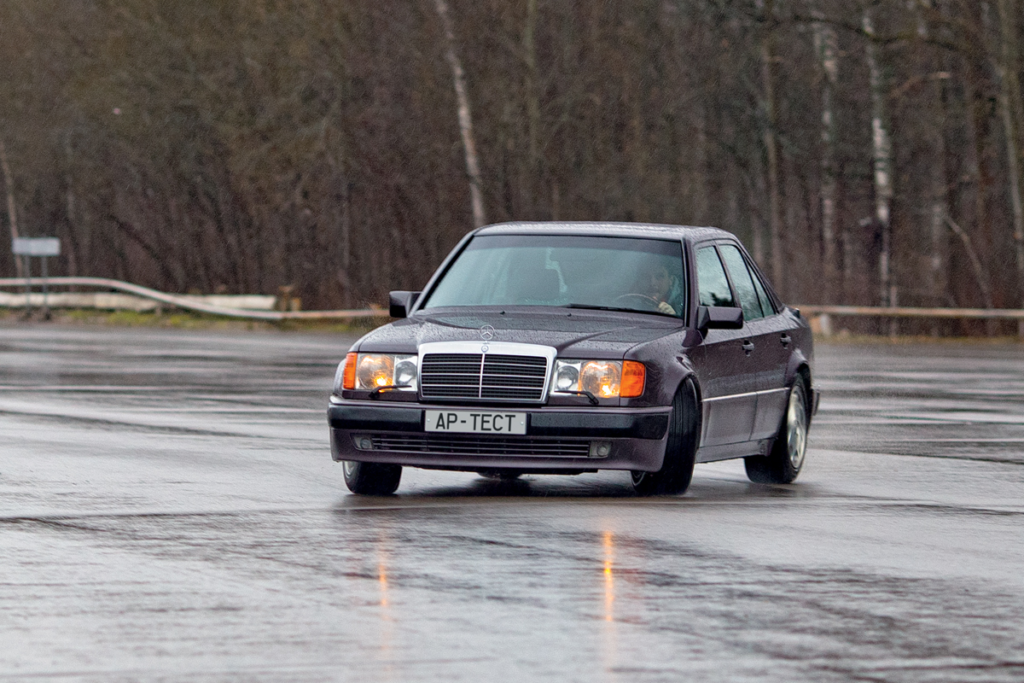
Jetzt bist du dran, M5, und zeigst, wie man es machen sollte.
Ist Ihnen schon mal aufgefallen, dass der BMW E34 nie lächelt? Er ist immer auf das Ergebnis fokussiert, und alle seine Linien laufen vorne zusammen und zeigen dorthin, wohin die Scheinwerfer gerichtet sind. Er ist gedanklich schon weiter, hat den Weg zurückgelegt und wartet darauf, dass Sie genauso gut, wenn nicht sogar besser abschneiden. Das ist die Essenz seines fokussierten Blicks.
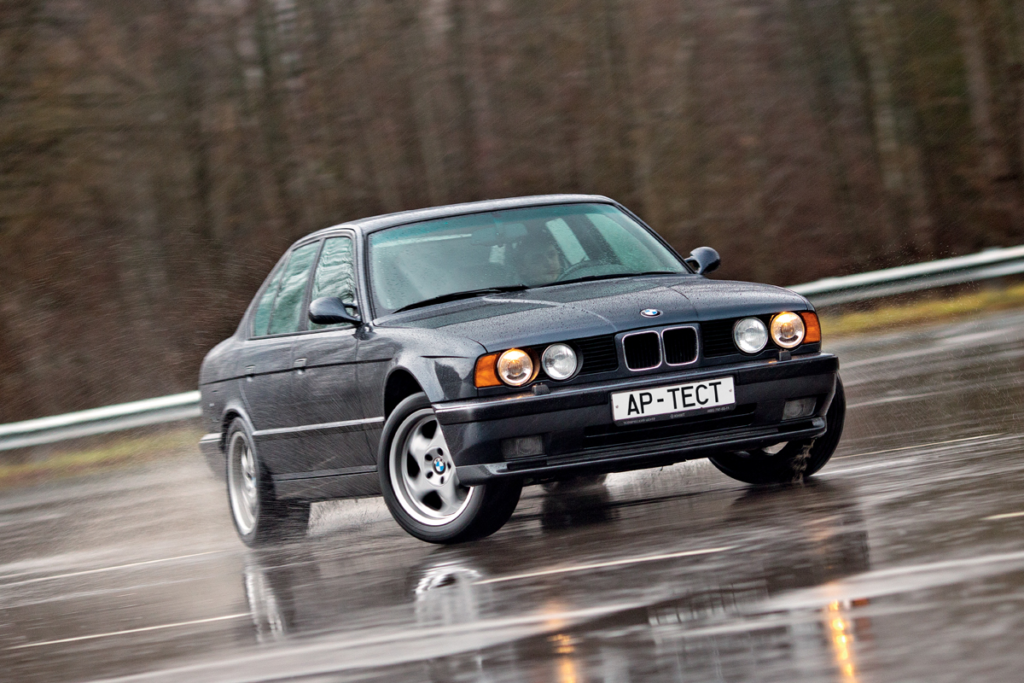
Der Innenraum ist nach der gleichen Philosophie gestaltet: alles konzentriert sich auf den Fahrer. Von meinem E39 kommend, fühle ich mich hier fast wie zu Hause. Fast, denn im Gegensatz zum E39 lässt sich das Lenkrad des E34 nicht verstellen, und das Bedienfeld für die Klimaanlage ist mit Knöpfen und Schiebereglern unterschiedlicher Größe überladen. Aber der Sitz bietet perfekten Halt, die Sitzposition scheint noch tiefer zu sein, und der Schalthebel für das Fünfgang-Schaltgetriebe bewegt sich präziser und mit kürzerem Hub als bei jedem anderen Retro-BMW, den ich kenne.
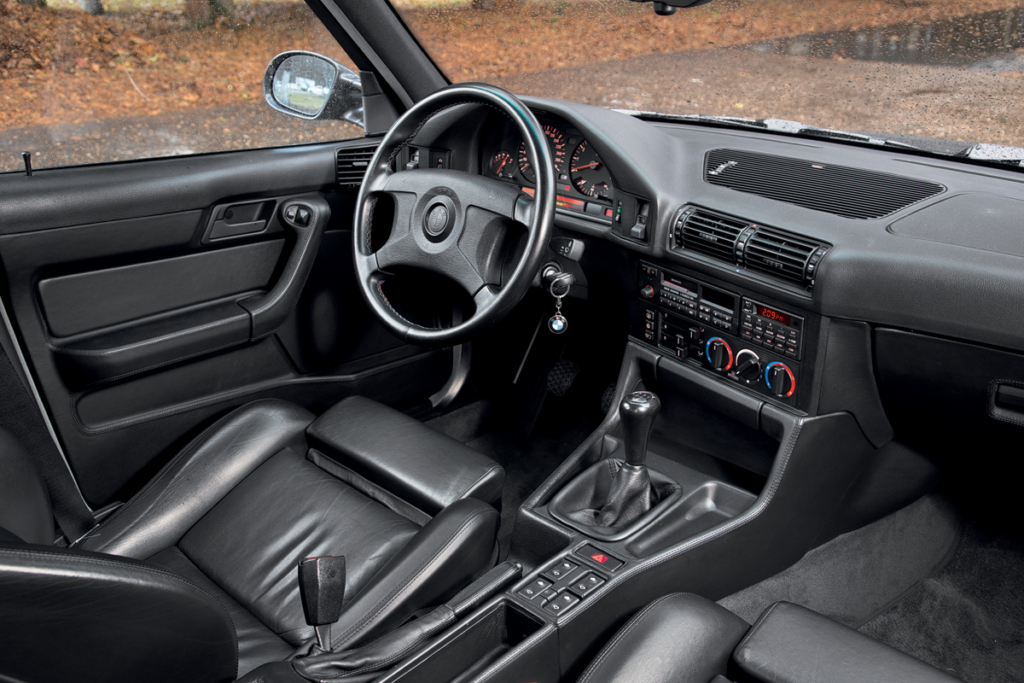
Im Alltag ist das M Auto kein Psychotherapeut, sondern ein Motivationscoach. Es beruhigt, indem es das Gegenteil tut. Sie fühlen sich ausgebrannt? Drehen Sie den Schlüssel und lassen Sie sich vom Schein der Instrumentenbeleuchtung anstecken. Nicht in Stimmung? Drücken Sie ein paar Mal auf das Gaspedal und lauschen Sie dem Klang des Lebensdurstes. Sie sind zuversichtlich und denken, dass Sie alles mühelos bewältigen können? Lassen Sie die Kupplung los und fordern Sie sich erneut heraus.
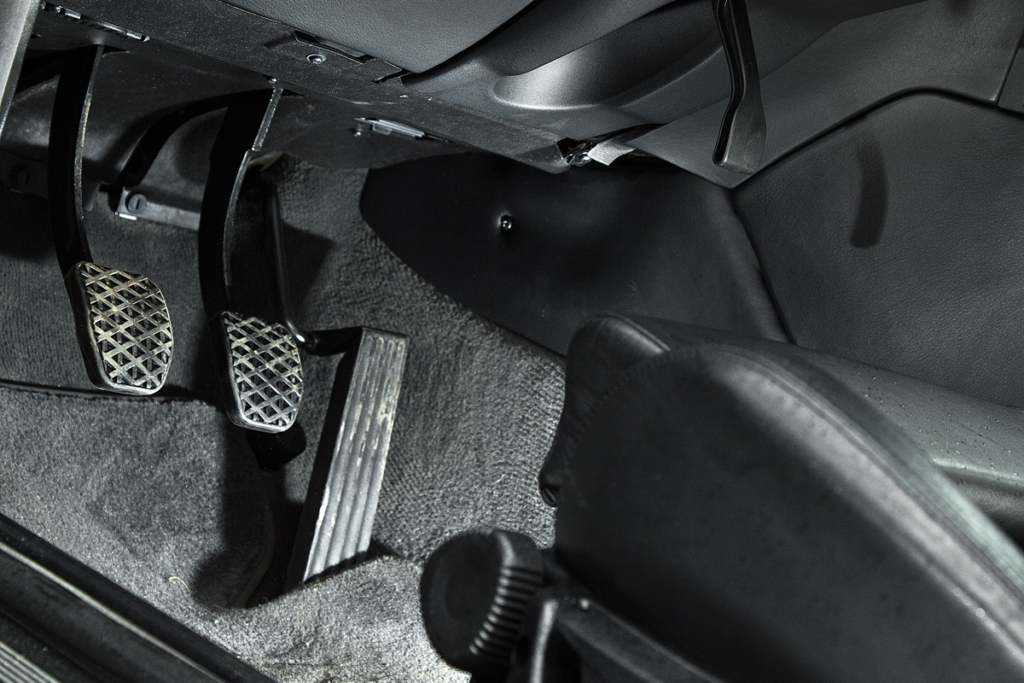
Hier gibt es keine Zweideutigkeiten. Der BMW fährt von Anfang an mit festem, präzisem Griff. Die Lenkung ist schwer, immer voller Kraftaufwand, die Reaktionen sind blitzschnell, und Wankbewegungen sind praktisch nicht vorhanden. Die M-Plakette leuchtet auf dem Armaturenbrett, der Tacho geht bis 300 km/h, und die einzige Fahrhilfe ist ein verstellbarer, automatisch abblendender Rückspiegel.
Jetzt, unter den ersten Regentropfen, sind wir auf der gleichen Geraden und versuchen, den schnell schwindenden Herbst einzuholen und den Mercedes zu überholen.
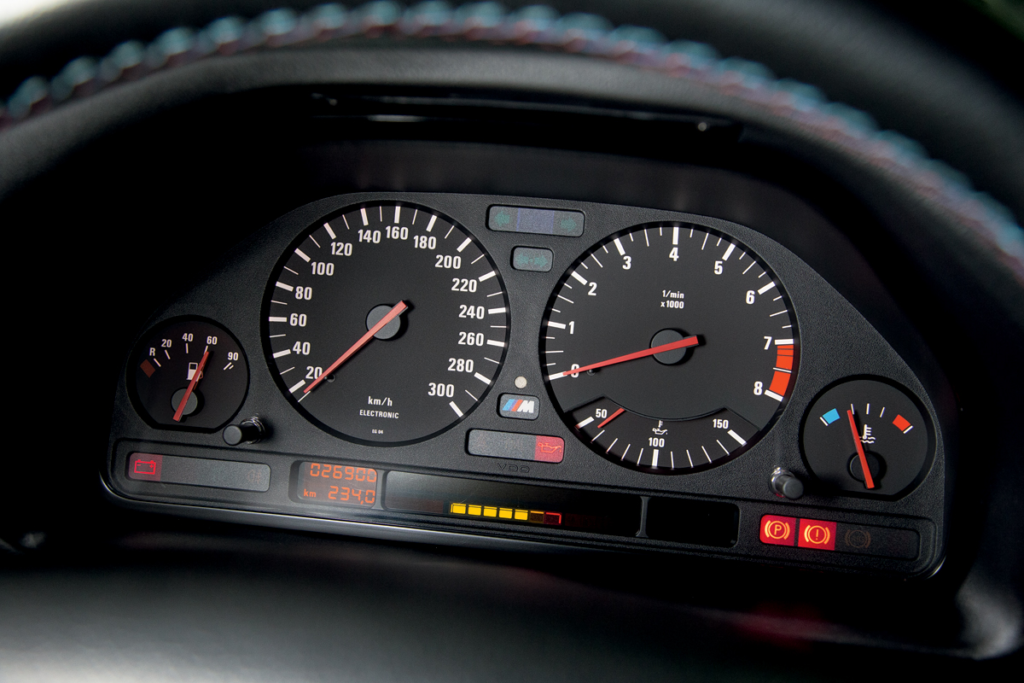
Für den überarbeiteten M5 wurde der Hubraum von 3,6 auf 3,8 Liter vergrößert, was das Drehmoment im unteren und mittleren Drehzahlbereich erhöht. Unter 4000 Umdrehungen pro Minute fehlt es aber immer noch an Durchzug. Im Idealfall würde man bei fünftausend Umdrehungen pro Minute starten, aber die Hinterräder drehen unweigerlich durch. Also schalte ich auf 3500 Umdrehungen pro Minute zurück und lasse die Kupplung etwas sanfter als nötig los. Wir sind süchtig. Der Sound füllt nicht nur den Innenraum, er durchdringt ihn vom Motorblock bis zum Auspuffrohr.
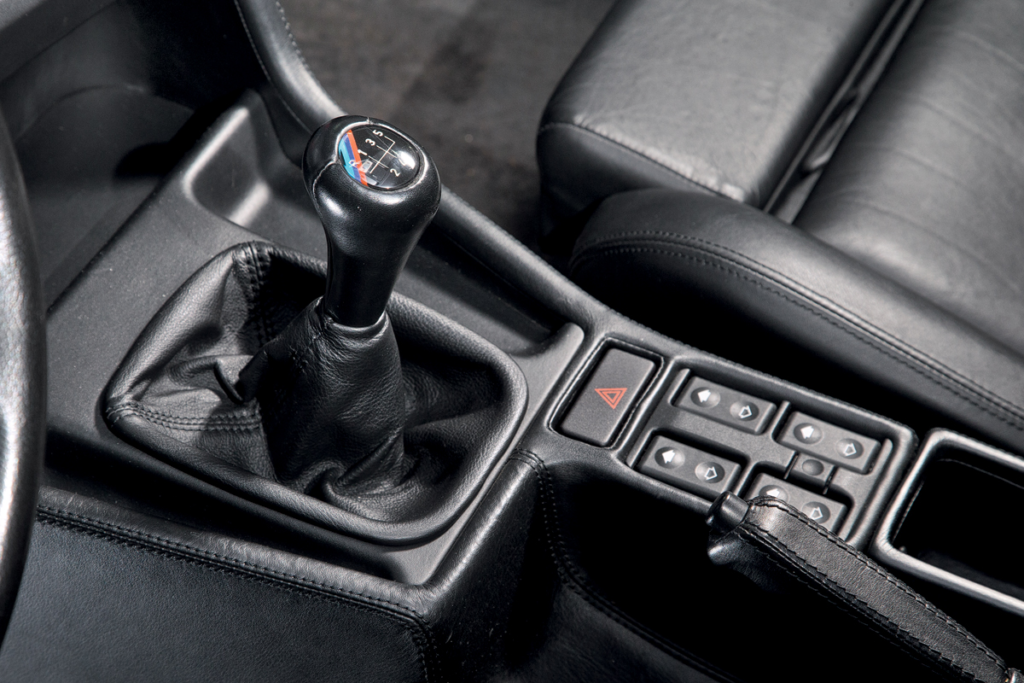
Die Tachonadel tanzt zwischen 5000 und 7500 U/min. Nach Erreichen von 140 km/h setzt in der Nähe der vorderen Dachsäule ein pfeifendes Geräusch ein – man spürt den Luftwiderstand, der das Auto aus der Bahn zu drängen versucht, aber der M5 hält seine Flugbahn viel genauer als der Mercedes. Bei 220 km/h im fünften Gang hört die Beschleunigung erst auf, wenn der Tacho 260 km/h anzeigt. In Wirklichkeit sind es 247,8 km/h. An dieser Stelle sollte der elektronische Begrenzer des M5 eingreifen, aber der Motor nähert sich ihm so sanft, dass es sich anfühlt, als ob er noch weiter gehen könnte.
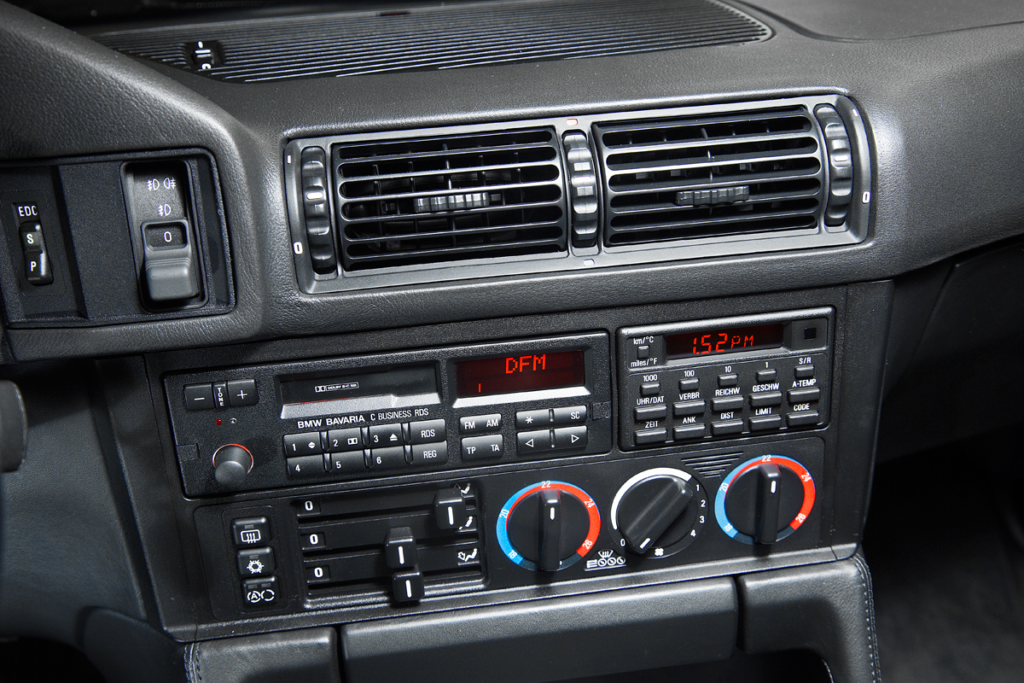
Im besten Fall übertrifft der M5 den „Fünfhunderter“ knapp, wenn auch nur symbolisch: 6,9 Sekunden auf 100 km/h und 15,9 Sekunden von 100 auf 200 km/h. Die Spitzenbeschleunigung ist höher (1,0 g), aber die Beschleunigung hat keinen Aha-Effekt. Es gibt keinen Werwolf-Effekt. Stattdessen erfolgt die Verwandlung gleich zu Beginn jeder Fahrt, nicht während der Beschleunigung. Darin unterscheidet er sich vom Mercedes.
Beide Autos haben etwa eine Sekunde aus ihren Passdaten verloren. Es ist einfach, dies dem Wetter zuzuschreiben, aber ich war von der Gaspedalbetätigung des M5 fasziniert, die sich wie ein elektronisches Gaspedal verhält, obwohl sie tatsächlich über ein Metallkabel mit den einzelnen Drosselklappen verbunden ist. Dennoch ist das Ansprechverhalten etwas gedämpft, und für Gaspedalbetätigungen muss man das Pedal etwas länger als gewöhnlich gedrückt halten.
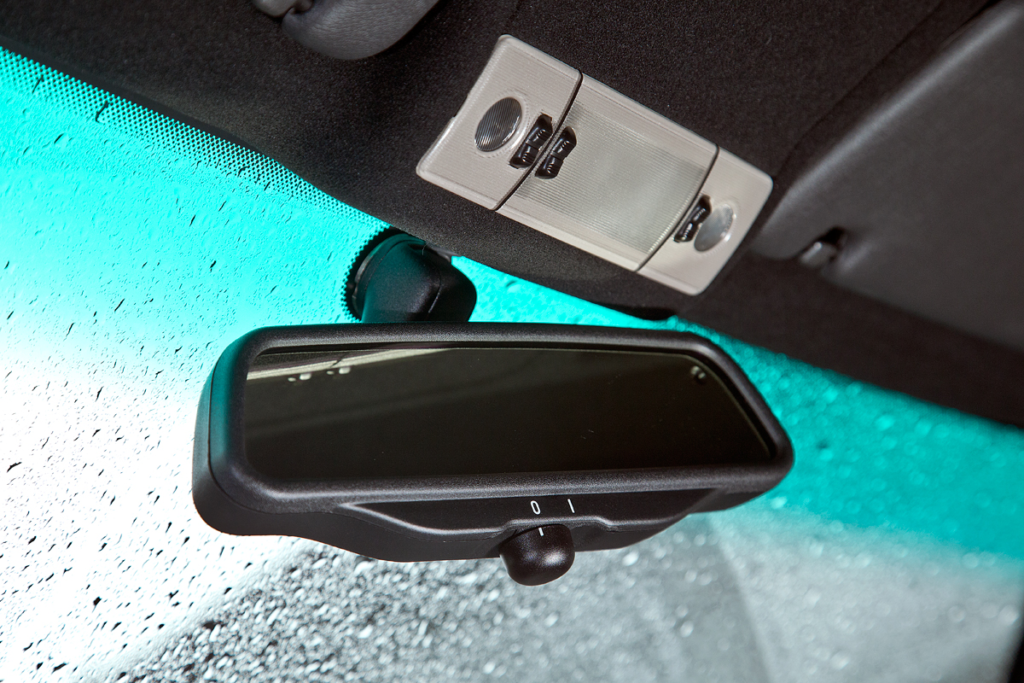
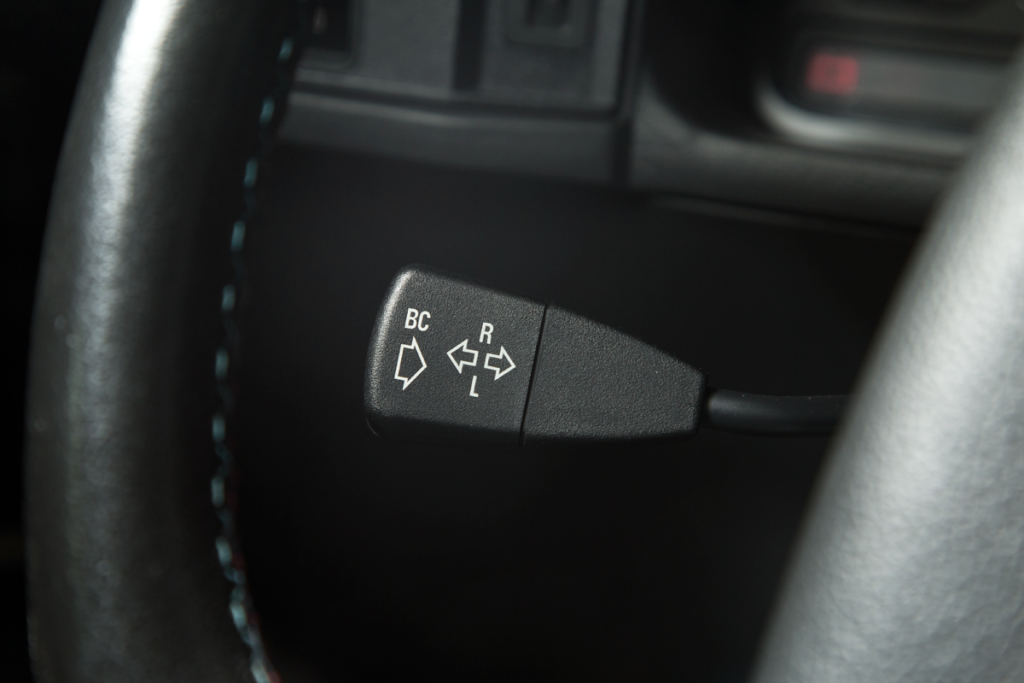
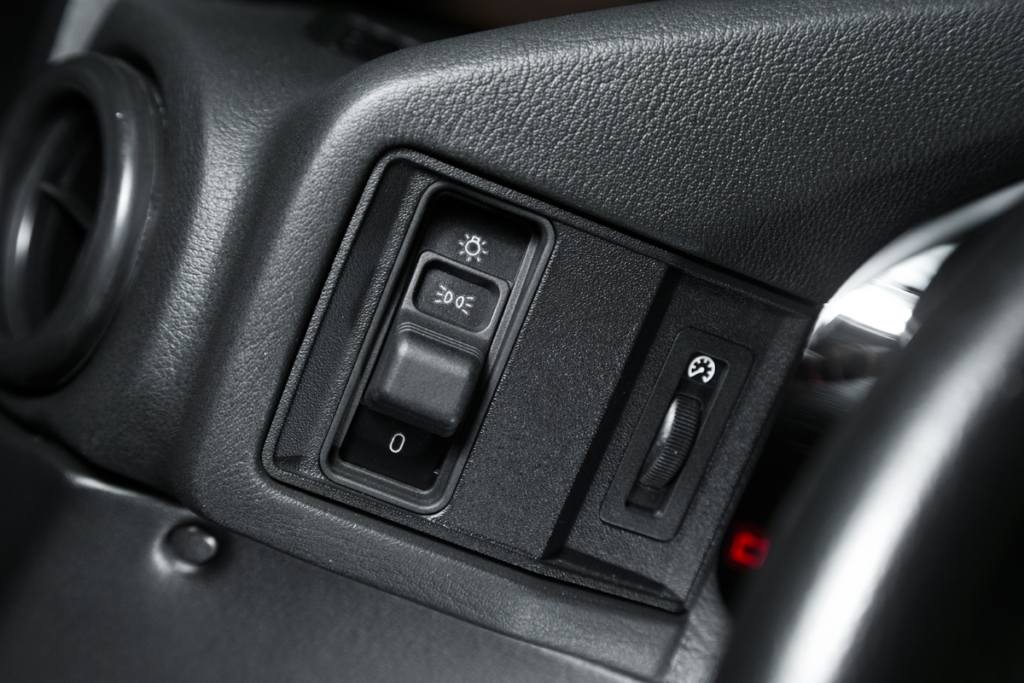
Überraschenderweise mag der M5 3.8 das Driften nicht besonders. Es ist kaum zu glauben, aber selbst auf nassem Asphalt muss man ihn bewusst provozieren, um die Traktion zu verlieren, sonst rutschen die Vorderräder zuerst. Um einen Drift einzuleiten, muss man die volle Kraft auf die breiten Hinterräder lenken und die Drehzahl hoch halten, damit die Reifen nicht wieder Traktion gewinnen und der M5 sich selbst stabilisiert. Trotz eines „verkürzten“ Differentials hat der M5 immer noch eine lange Lenkübersetzung (3,25 Umdrehungen von Sperre zu Sperre) und einen eingeschränkten Lenkeinschlag im Vergleich zu den Standard-E34-Modellen aufgrund der breiten Reifen. Diese Beobachtungen könnten zu einer Neubewertung der ikonischen Driftszenen in Tiflis führen.
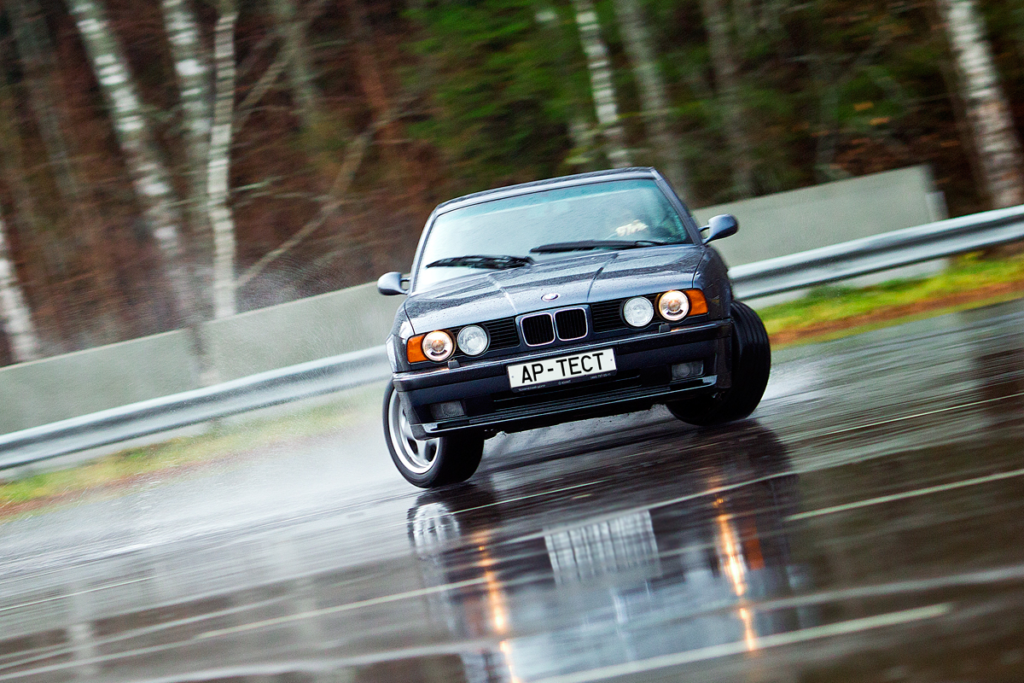
Umgekehrt erwies sich der Mercedes als angenehm driftfreudig. Hubraum und Drehmoment reichen aus, um die Hinterräder durchdrehen zu lassen, was aber durch das nicht deaktivierbare ASR-System kurzzeitig unterbunden wird. Das ist schade, denn der W124 reagiert zunächst am Limit mit Heckrutschen. In Situationen, in denen das ASR nachlässt, überlässt der Mercedes dem Fahrer bereitwillig die volle Kontrolle. Ohne die Elektronik wäre er ein aufregendes und reaktionsschnelles Auto – ein gezügelter Werwolf.
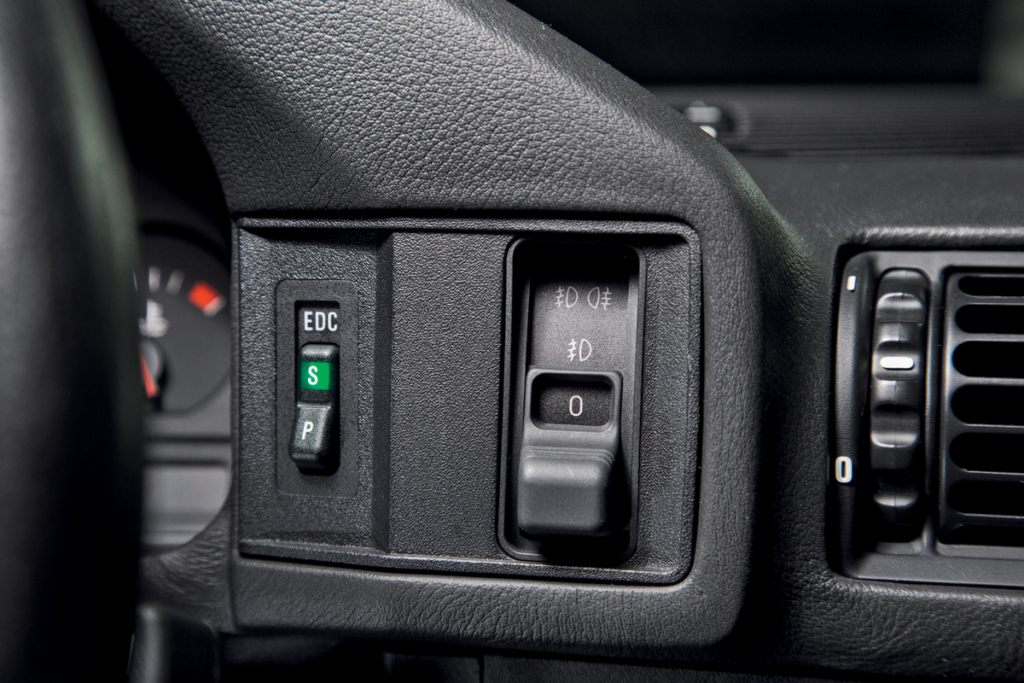
Und doch besitzt der BMW eine Magie, die einen „wow“ ausrufen lässt. Der Grund dafür ist das EDC-Fahrwerk mit elektronisch gesteuerten Boge-Dämpfern. Es gibt nur zwei Modi: „Sport“, das eine straffe M-Federung bietet, die unnötige Bewegungen einschränkt, und ‚Adaptiv‘, das den Dämpfern mehr Spielraum lässt, um Unebenheiten der Straße auszugleichen. Diese Einstellung ist zwar nicht so weich wie bei einem Mercedes, kommt aber dem für den Alltag notwendigen Komfort sehr nahe.
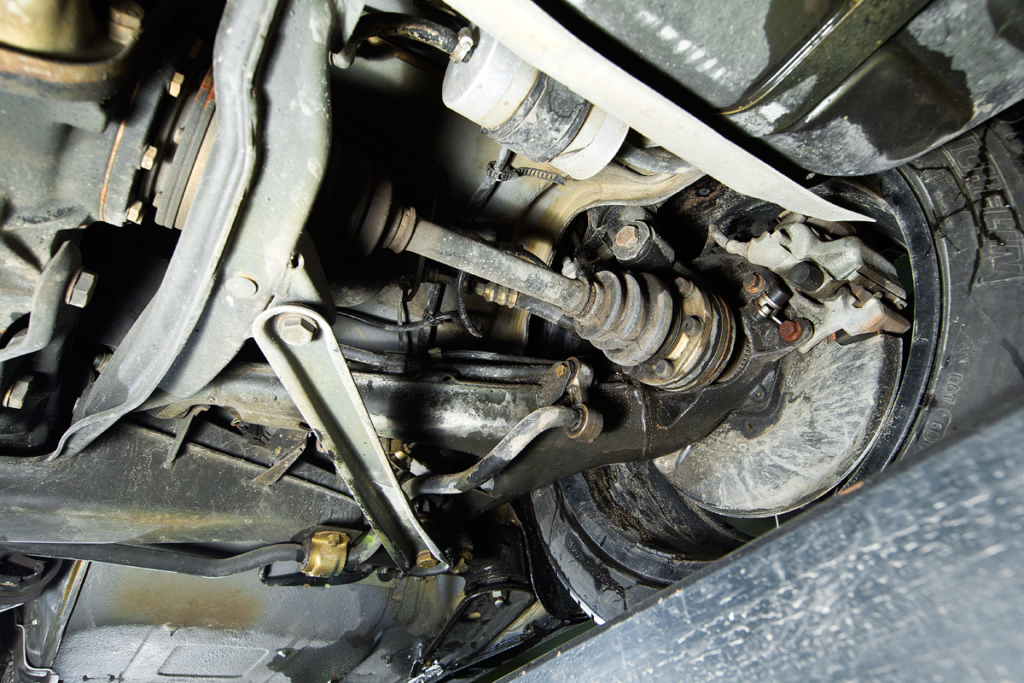
Mir wurde klar, dass die unerwartetste, aber logische Schlussfolgerung aus dem Test diese ist: Der BMW M5 ist perfekt für eine Rolle, die man dem Mercedes zuschreiben würde. Er ist ein Werwolf, der keine hohen Drehzahlen braucht, um sich zu verwandeln. Die Magie des M5 setzt sofort ein und sorgt dafür, dass man auch ohne Rennstrecke oder Autobahn eine transformative Ladung erlebt. Er spendet Energie, Gelassenheit, Motivation und Vorwärtsdrang – ein unverzichtbarer Coach für den Alltag.
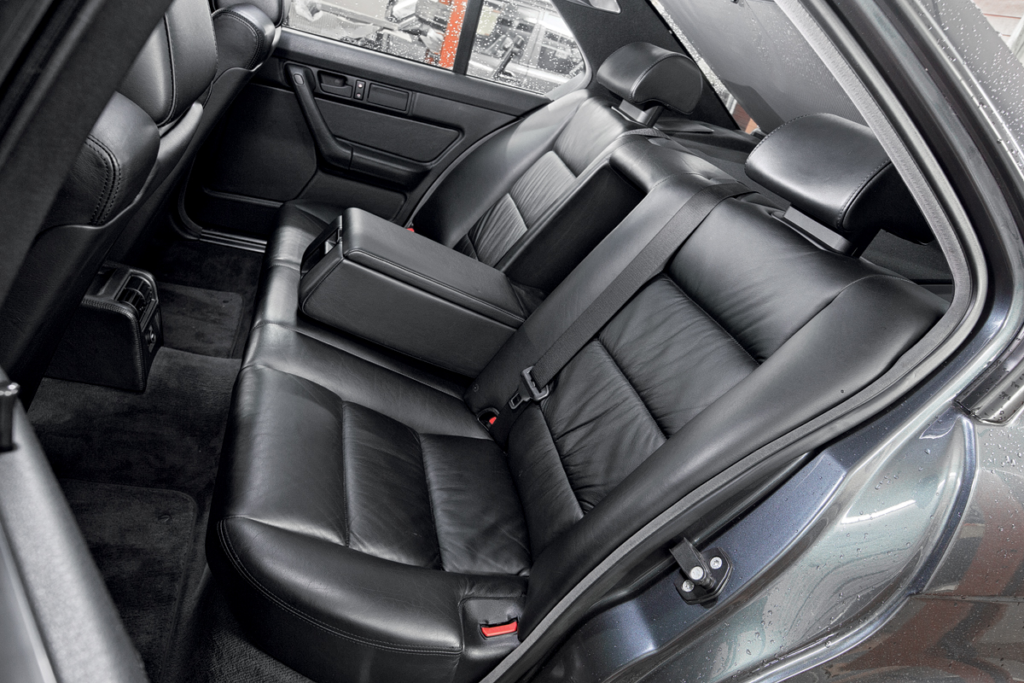
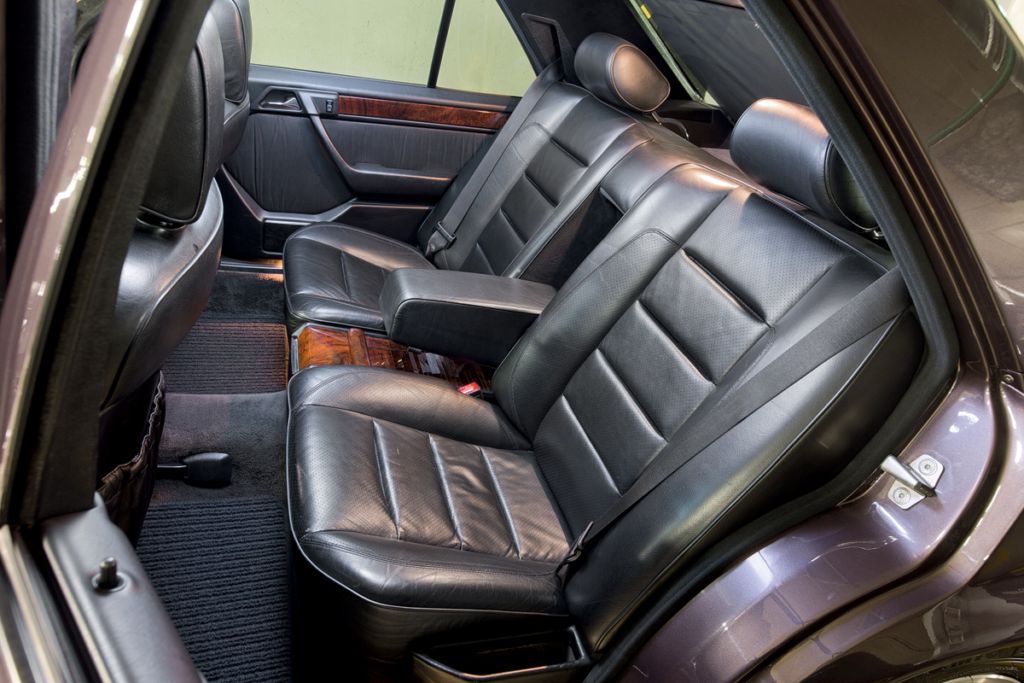
Im täglichen Leben mit dem Mercedes finden wir beide ihn vielleicht etwas alltäglich. Er ist ein Vulkan, der von der Leichtigkeit lebt, sich in ein Monster zu verwandeln, aber solche Verwandlungen brauchen Platz und die Möglichkeit, an jeder Ampel voll zu beschleunigen. Wenn man sich also für…
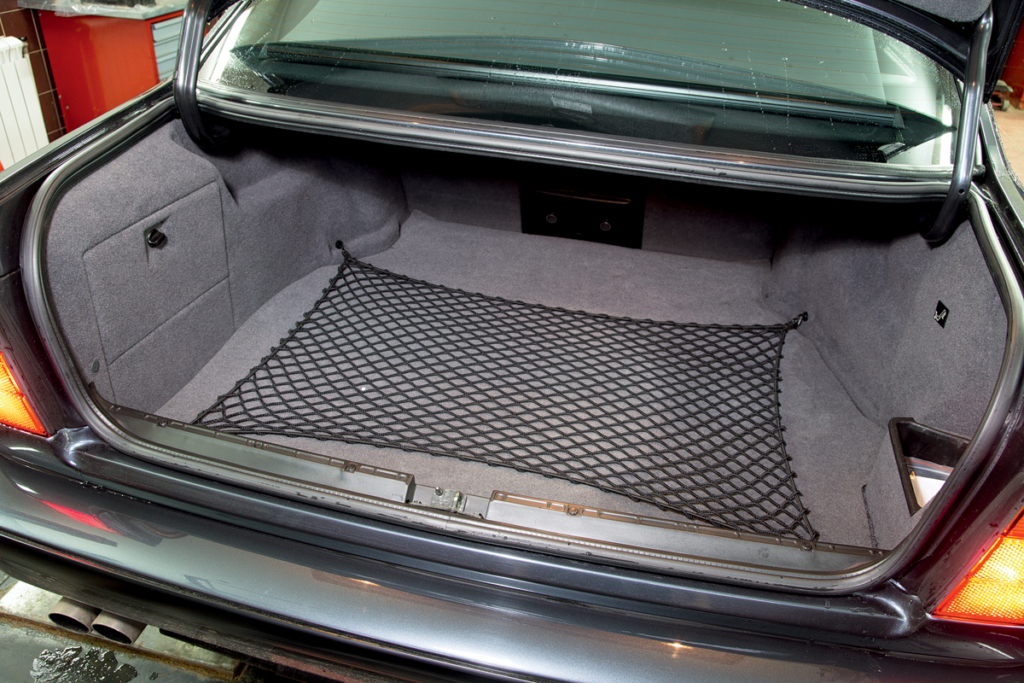
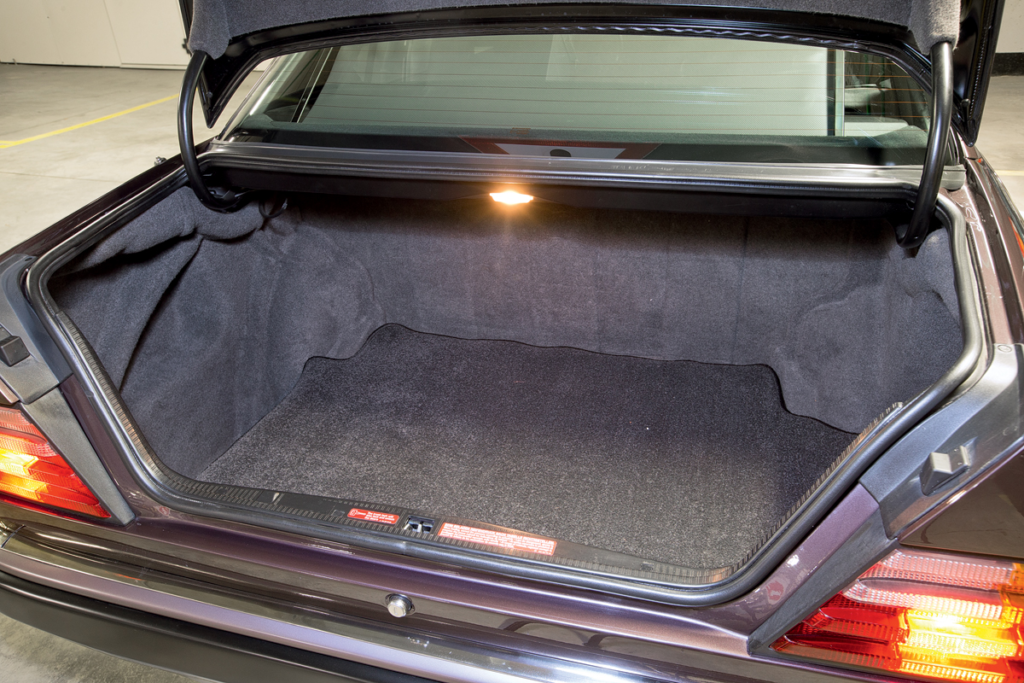
Seien wir ehrlich. Solche Autos sind selten die einzigen Bewohner einer Garage, und ihre Besitzer müssen sich in der Regel nicht nur für eines entscheiden. Meiner Meinung nach würde die ideale Garage beide Fahrzeuge beherbergen. Dies spiegelt den Wert der Ära wider, in der der M5 und der 500 E-BMW und Mercedes geboren wurden, die sich gegenseitig bedrängten, aber weder imitierten noch duplizierten. Sie schufen Fahrzeuge, die sich in alles verwandeln konnten und doch unverwechselbar blieben.
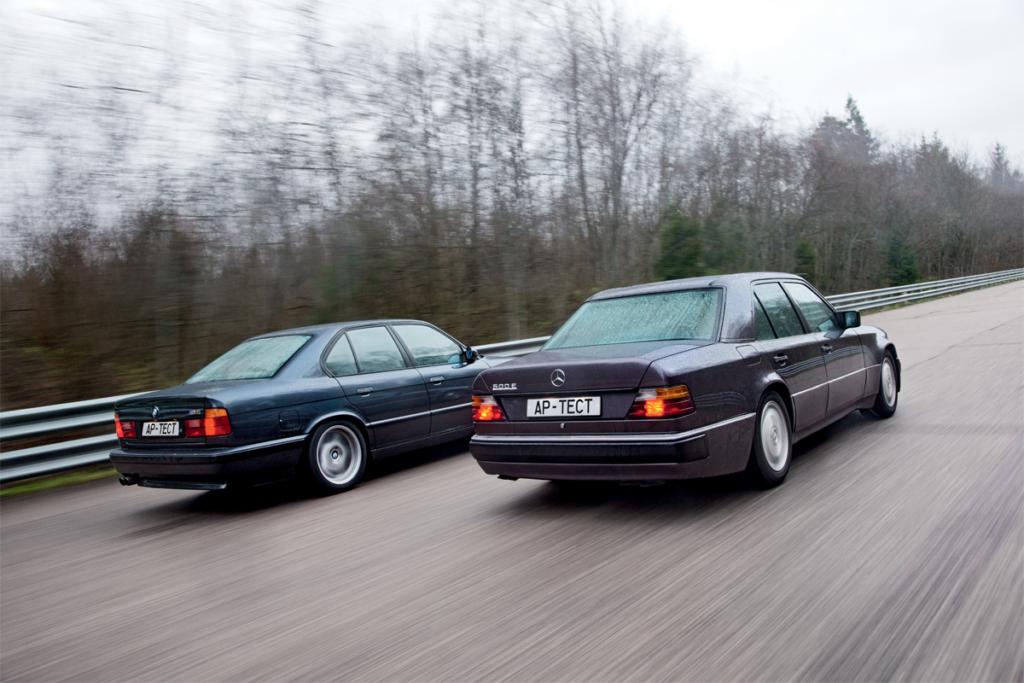
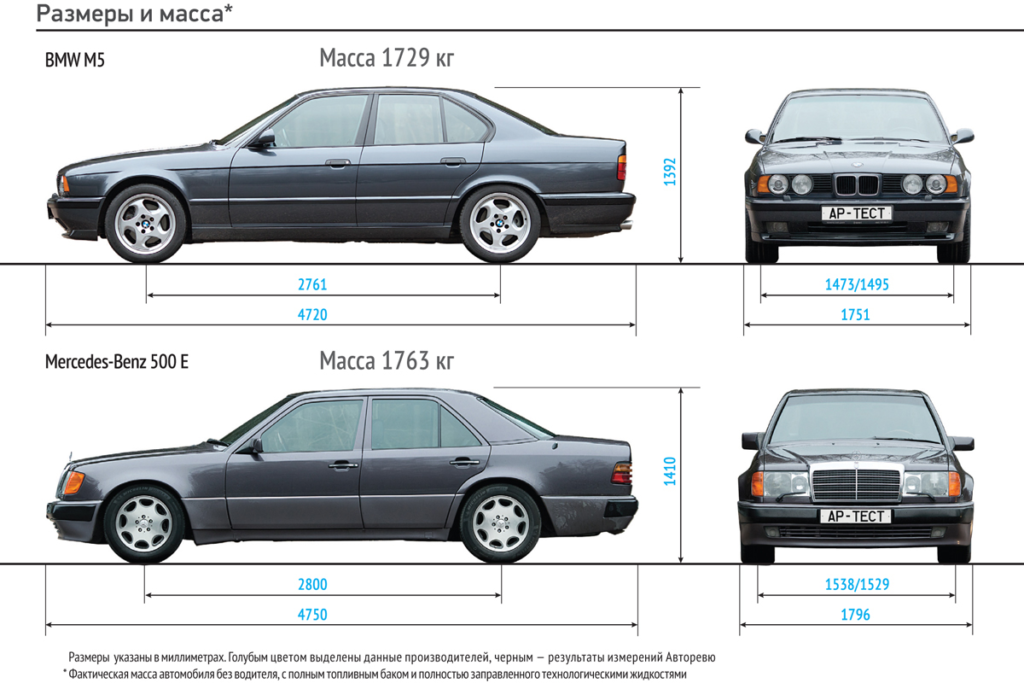
| Spezifikation | BMW M5 | Mercedes-Benz 500 E |
|---|---|---|
| Körpertyp | Viertürige Limousine | Viertürige Limousine |
| Anzahl Sitzplätze | 5 | 4 |
| Kofferraumvolumen (Liter) | 460 | 485 |
| Leergewicht (kg) | 1725 | 1710 |
| Gesamtgewicht des Fahrzeugs (kg) | 2150 | 2160 |
| Motortyp | Benzin, mit verteilter Einspritzung | Benzin, mit verteilter Einspritzung |
| Motorposition | Vorne, längs | Vorne, längs |
| Anzahl und Anordnung der Zylinder | Inline 6 | Der V8 |
| Hubraum (cc) | 3795 | 4973 |
| Anzahl Ventile | 24 | 32 |
| Zylinderdurchmesser/Hub (mm) | 94.6/90.0 | 96.5/85.0 |
| Kompressionsrate | 10.5:1 | 10.0:1 |
| Maximale Leistung (PS/kW/U/min) | 340/250/6900 | 326/240/5600 |
| Maximales Drehmoment (Nm/U/min) | 400/4750 | 480/3900 |
| Übertragung | 5-Gang-Schaltgetriebe | Automatik, 4-Gang |
| Laufwerkstyp | Heckantrieb | Heckantrieb |
| Vorderradaufhängung | Unabhängig, Schraubenfedern, McPherson | Unabhängig, Schraubenfedern, McPherson mit getrennter Feder und Stoßdämpfer |
| Hinterradaufhängung | Unabhängig, Schraubenfedern, Schräglenker | Einzelradaufhängung, Schraubenfedern, Mehrlenker |
| Reifengröße | 235/45 R17 | 225/55 R16 |
| Höchstgeschwindigkeit (km/h) | 250* | 250* |
| Beschleunigung 0—100 km/h (s) | 5.9 | 6.1 |
| Kraftstoffverbrauch im gemischten Zyklus (l/100 km) | 12 | 13.5 |
| Tankinhalt (Liter) | 80 | 90 |
| Treibstoffart | Benzin AI-95 | Benzin AI-95 |
Foto: Dmitry Pitersky
Dies ist eine Übersetzung. Einen Originalartikel können Sie hier lesen: Über den Autor und weitere Mitwirkende

Veröffentlicht Juli 18, 2024 • 16 m zum Lesen

